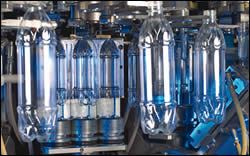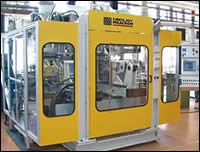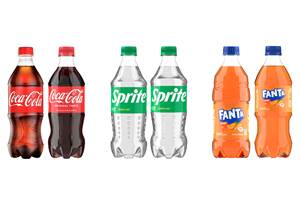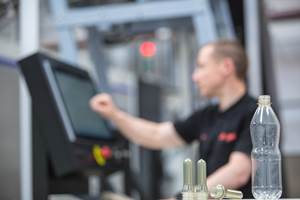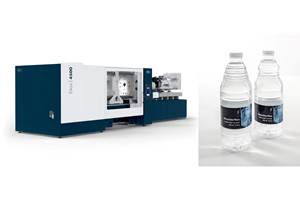K 2004 News Preview: Blow Molding
One of the most interesting innovations in blow molding at K 2004 will be a top-and-bottom blowing system that is said to double bottle output.
One of the most interesting innovations in blow molding at K 2004 will be a top-and-bottom blowing system that is said to double bottle output. For energy savings, there are also a couple of new all-electric extrusion blow machines, plus a wheel machine with an electromechanical clamp and a one-stage stretch-blow system with electric injection unit. In addition, there will be a wide variety of extrusion blow, injection-blow, and stretch-blow machines with various enhancements aimed at higher productivity, increased versatility, and faster mold changes.
Extrusion blow variety
Bekum plans to demonstrate a new multi-cavity extrusion blow process, called tandem extrusion blow molding, on its BM-206 shuttle machine. Tandem blowing reportedly doubles the productivity of a standard machine by blowing two rows of bottles—one from the top and one from the bottom—simultaneously. Bekum developed this process for single-serve 100- to 300-cc bottles for milk-based beverages, sports drinks, and juices.
Meanwhile, the ranks of all-electric machine suppliers slowly expands, as Plastimac SpA of Italy (represented here by American Jet Stream) will launch single- and double-station electric shuttles that deliver low energy consumption and are oil-free. The PB1/S has two cavities, clamp force of 3.5 tons, and a 50-mm extruder. It is targeted for 1-liter cosmetic bottles. The PB5/D is a double-station electric unit with six cavities, 80-mm extruder, and clamp force of 10 tons. It’s aimed at 5L detergent and oil containers and has an output of 2400 bottles/hr.
A new shuttle machine, described as “value-packed” with lots of features at no price premium, will be introduced by Uniloy Milacron. Model UMS 16D boasts an exceptionally small footprint, tiebarless accessibility to the mold area, in-machine trimming, and closed-loop position and speed control. It can handle two to six parisons in single- or dual-station configurations. Clamp movement is strictly horizontal, so the machine can accommodate a bobbing extruder. This model was designed to accept existing molds built for almost any other machine—no other machine is so adaptable, Milacron claims.
Graham Machinery Group will focus on reciprocating-screw technology and will introduce a proportionally controlled, high-speed hydraulic clamping system for high-cavitation molding of gallon dairy containers. Graham will show a cutaway of an air-cooled reciprocating extruder, a standard feature on its newer machines.
Graham will also highlight its latest high-throughput extrusion heads for polycarbonate water bottle production and other applications on its Hesta-Graham linear shuttle machines.
New from Jomar is a version of its EBM 6.0 extrusion blow machine with a 90-mm extruder and longer stroke (685 mm). The dual-station model EBM 6.0-D-L/S will run two eight-cavity molds for 300-cc Boston round HDPE cosmetic containers on a 12-sec cycle, producing 4800 bottles/hr.
The latest wheel machine from Wilmington Machinery is the Series III, a large-platen unit with 30 stations and up to 60 cavities (with dual parisons). It combines six-layer coextrusion, energy-saving electromechanical clamp system, and improved bottle handling to boost throughput. Wilmington says mold changes are fast and simple and positioning of the molds to minimize flash and scrap is made effortless with the company’s “radial positioning” feature. The Series III is offered in sizes for single-serve juice and dairy containers and in larger models for 5L and 6L containers. Output can range from a few thousand to over 20,000 bottles/hr.
Another new wheel system comes from Urola S.C. of Spain, which just recently opened its first U.S. office. At K 2004, the company will introduce a 20-station wheel designed to compete with large rotary-machine makers like Graham Machinery and Wilmington, says Urola USA general manager Lou Maiero. Previously, Urola primarily served the European market with smaller rotary machines of up to 14 stations.
The new M20 rotary consists of two 10-station wheels with a common center plate and two extruders. The two streams of bottles pass through a common trimmer. Maiero says this side-by-side wheel design is the first on the market and costs less, uses less energy, and occupies less floor space than bigger competing wheel machines. It is targeted for HDPE containers for chemical, dairy, and food applications.
Versatile PET units
Although PET machinery was a major focus of new developments at the last K show, most suppliers did not release information on new models in advance of the show. An exception was SIPA of Italy, which claims to set a new standard for flexibility in PET bottle production with its SFR 9/27 rotary reheat machine. The unit’s nine blowing stations can mount three-cavity molds for single-serve bottles or single-cavity molds for family-size containers. The machine puts out 40,000 bottles/hr at 0.6 liters and 15,000/hr for a 3L size.
Also notable about the SFR 9/27 are its small footprint (one-half to one-third that of competing machines), its simple mechanical set-up, and a preform heating and stabilizing system that reportedly allows a wide processing window.
In addition, Automa of Italy will unveil a one-stage injection stretch-blow molder for wide-mouth PET containers. Model NSB 140 has a 140-ton injection clamp, up to 14 cavities, and an electric-powered injection unit. Dry-cycle time is said to be just 3 sec.
Injection-blow targets PET
At least two injection-blow molding exhibits will emphasize production of unoriented PET bottles. Novapax of Germany will show a new four-station machine for high production of PET containers. The NSB 850/400, with a 93-ton preform clamp, is said to compete with larger three-station machines by accommodating a 35.4-in. transfer head to run high-cavitation molds. It runs 60-cc wide-mouth tablet bottles in 17 cavities and 200-cc wide-mouth bottles in 12 cavities. The unit comes with a Siemens Siemotion touchscreen control system, a new rapid indexing unit, and an electric screw drive for precise plasticating control when handling sensitive resins. Novapax says the NSB 850 can also run existing molds for three-station injection-blow machines, requiring only additional core rods, interchange parts, and minor mold adjustments for fit.
Jomar Corp. is introducing two high-production injection-blow units. The M-40 model with 38-ton preform clamp will run a six-cavity mold at the show, producing 10-cc oval PET bottles for cosmetics or hotel amenities. The machine boasts a 10-sec cycle and produces 2160 bottles/hr. Jomar said many of its late-model injection-blow machines can be modified to produce small PET bottles up to 150 cc.
Jomar’s new M-85-S (72 tons) will be shown running a 10-cavity mold producing 100-cc HDPE pharmaceutical containers. The machine runs a 11.5-sec cycle, producing 3130 bottles/hr. It can run bottles from 5 cc to 1L.
Related Content
Coca-Cola’s Redesign of Small PET Bottles Pushes Lightweighting Below Prior ‘Floor’
Coca-Cola thought it had reached the limits of lightweighting for its small PET carbonated soft drink bottles. But a “complete redesign” led to a further 12% reduction.
Read MoreServices to Help Blow Molders Convert to rPET
Sidel launches “RePETable” range of services as “one-stop” solution to efficient adoption of rPET for bottle production.
Read MoreKrones Acquires Netstal
Krones adds PET preform injection molding to its bottle blowing and filling capabilities, as well as cap molding and expansion into medical, food and other markets.
Read MoreBrewer Chooses Quick-Change Flexibility to Blow Wide Range of PET Beer Bottles
Beermaster Brewery found a “universal” stretch-blow machine from PET Technologies enables multiple changes per day among four sizes of beer bottles.
Read MoreRead Next
See Recyclers Close the Loop on Trade Show Production Scrap at NPE2024
A collaboration between show organizer PLASTICS, recycler CPR and size reduction experts WEIMA and Conair recovered and recycled all production scrap at NPE2024.
Read MoreMaking the Circular Economy a Reality
Driven by brand owner demands and new worldwide legislation, the entire supply chain is working toward the shift to circularity, with some evidence the circular economy has already begun.
Read MorePeople 4.0 – How to Get Buy-In from Your Staff for Industry 4.0 Systems
Implementing a production monitoring system as the foundation of a ‘smart factory’ is about integrating people with new technology as much as it is about integrating machines and computers. Here are tips from a company that has gone through the process.
Read More



